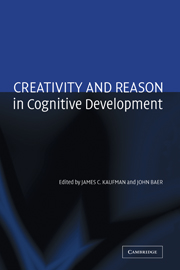Book contents
- Frontmatter
- Contents
- List of Contributors
- Acknowledgments
- Creativity and Reason in Cognitive Development
- Introduction
- COGNITIVE PERSPECTIVES
- 1 Expertise and Reason in Creative Thinking: Evidence from Case Studies and the Laboratory
- 2 Creative Genius, Knowledge, and Reason: The Lives and Works of Eminent Creators
- 3 Dynamic Processes Within Associative Memory Stores: Piecing Together the Neural Basis of Creative Cognition
- 4 The Creativity of Everyday Moral Reasoning: Empathy, Disgust, and Moral Persuasion
- 5 Reasoning and Personal Creativity
- 6 Alternative Knowledge Structures in Creative Thought: Schema, Associations, and Cases
- 7 The Role of the Knowledge Base in Creative Thinking
- 8 The Role of Domain Knowledge in Creative Problem Solving
- 9 Creative Thinking and Reasoning: Can You Have One Without the Other?
- 10 From Alexithymia, Borne of Trauma and Oppression, to Symbolic Elaboration, the Creative Expression of Emotions, and Rationality
- 11 Opening up Creativity: The Lenses of Axis and Focus
- DEVELOPMENTAL AND EDUCATIONAL PERSPECTIVES
- Author Index
- Subject Index
- References
8 - The Role of Domain Knowledge in Creative Problem Solving
Published online by Cambridge University Press: 19 January 2010
- Frontmatter
- Contents
- List of Contributors
- Acknowledgments
- Creativity and Reason in Cognitive Development
- Introduction
- COGNITIVE PERSPECTIVES
- 1 Expertise and Reason in Creative Thinking: Evidence from Case Studies and the Laboratory
- 2 Creative Genius, Knowledge, and Reason: The Lives and Works of Eminent Creators
- 3 Dynamic Processes Within Associative Memory Stores: Piecing Together the Neural Basis of Creative Cognition
- 4 The Creativity of Everyday Moral Reasoning: Empathy, Disgust, and Moral Persuasion
- 5 Reasoning and Personal Creativity
- 6 Alternative Knowledge Structures in Creative Thought: Schema, Associations, and Cases
- 7 The Role of the Knowledge Base in Creative Thinking
- 8 The Role of Domain Knowledge in Creative Problem Solving
- 9 Creative Thinking and Reasoning: Can You Have One Without the Other?
- 10 From Alexithymia, Borne of Trauma and Oppression, to Symbolic Elaboration, the Creative Expression of Emotions, and Rationality
- 11 Opening up Creativity: The Lenses of Axis and Focus
- DEVELOPMENTAL AND EDUCATIONAL PERSPECTIVES
- Author Index
- Subject Index
- References
Summary
Consider the word problems presented in Table 8.1. Some people are able produce solutions to these problems, whereas others make errors, get frustrated, and fail to generate a correct answer. What do successful mathematical problem solvers know that less successful mathematical problem solvers do not know? This seemingly straightforward question motivates this chapter.
A review of research on mathematical problem solving supports the conclusion that proficiency in solving mathematical problems depends on the domain knowledge of the problem solver (Kilpatrick, Swafford, & Findell, 2001). In this chapter, I examine the research evidence concerning five kinds of knowledge required for mathematical problem solving: (1) factual knowledge, (2) conceptual knowledge, (3) procedural knowledge, (4) strategic knowledge, and (5) metacognitive knowledge.
Table 8.2 provides definitions and examples of each of the five kinds of knowledge relevant to mathematical problem solving. Factual knowledge refers to knowledge of facts such as knowing that there are 100 cents in a dollar. Conceptual knowledge refers to knowledge of concepts such as knowing that a dollar is a monetary unit and knowledge of categories such as knowing that a given problem is based on the structure (total cost) = (unit cost) = (number of units). Strategic knowledge refers to knowledge of strategies such as knowing how to break a problem into parts. Procedural knowledge refers to knowledge of procedures such as knowing how to add two decimal numbers.
- Type
- Chapter
- Information
- Creativity and Reason in Cognitive Development , pp. 145 - 158Publisher: Cambridge University PressPrint publication year: 2006
References
- 12
- Cited by



